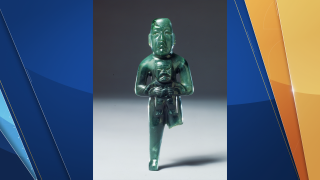
The Kimbell Art Museum has announced today the acquisition of one of the most renowned sculptures from ancient Mesoamerica, an unqualified icon of Olmec civilization. Standing Figure Holding a Were-Jaguar Baby (c. 900–300 B.C.), a statuette carved in jadeite, has been at the center of Olmec studies and the subject of scholarly interpretation since the mid-twentieth century. It becomes the most significant work of ancient American art in the Kimbell’s collection. The superb figure was acquired in celebration of the tenth anniversary of the Kimbell’s Renzo Piano Pavilion, where it will be the centerpiece of the museum’s ancient American collection beginning December 15, 2023.
The sculpture has been frequently published and exhibited since being acquired in 1947 by Alastair B. Martin of New York City, founder of the distinguished and celebrated Guennol Collection. Martin placed the figure on long-term loan to the Brooklyn Museum of Art, where it remained until 2014. It is first documented in 1829, when it was recorded in the possession of a priest, Manuel de Posada y Garduño (later Archbishop of Mexico from 1839 to 1846). It was then reputedly acquired by Prosper de Chasseloup-Laubat, 4th Marquis of Chasseloup-Laubat, and brought to Paris, France, by the 1860s. It descended through the Chasseloup-Laubat family before being purchased by Martin. Most recently, the sculpture has been displayed at the Cleveland Museum of Art.
This extremely refined and masterfully carved jade, though only 8.5 inches tall, conveys extraordinary power, gravitas, and ceremonial import. The luminous jewel-green statuette depicts an unclothed, standing Olmec ruler holding an infant were-jaguar, a supernatural creature that is part human and part jaguar. The baby displays all features typical of an Olmec were-jaguar: a V-shaped cleft at the top of its flat cranium; large, slanted, almond-shaped eyes; a foreshortened, broad nose with flared nostrils; and a gaping mouth with a flared upper lip turned down at the sides, revealing a fangless gum line. A headband with two nodules and pleated ear ornaments at the sides links the were-jaguar baby with the Olmec Supernatural, one of the culture’s most important deities, who controlled the rain and the growth of maize. The physical association between the male figure and the supernatural being in the Kimbell’s statuette would have validated the ruler’s authority, demonstrating his shamanic capabilities and access to the supernatural through ritual performances. Effigies such as this, carved from precious materials, were empowered objects and may have been animated in rituals or deposited in burials or caches with other magical objects in sacred precincts. The ruler’s left leg, missing from the mid-thigh, may have been broken in such a ritual.
Though there are eleven published Olmec sculptures that depict an adult human holding an infant were- jaguar, no two are identical. Of these, Standing Figure Holding a Were-Jaguar Baby is the only example carved in precious jade and one of only three that portray the human figure standing and holding the infant vertically across the chest, rather than seated and interacting with the infant in its lap. Only one other known sculpture shows the infant wearing the headband explicitly linking it to the Olmec Supernatural.
Get DFW local news, weather forecasts and entertainment stories to your inbox. Sign up for NBC DFW newsletters.
In the ancient Mesoamerican world, jade was highly prized for its rich green color, which was closely associated with maize and the attendant ideas of sustenance, fertility, preciousness, and enduring life. The surface of this exquisite, translucent, sea-green jade with deep emerald veins is polished to a mirrorlike shine—a hallmark of the most refined Olmec jade sculptures. Along with the skillful carving, these attributes attest to the importance of this object; such an extraordinary stone was most evidently entrusted to an exceptional artist to carve.
Standing Figure Holding a Were-Jaguar Baby joins important works of art representing the ancient Teotihuacan, Maya, Zapotec, and Aztec cultures of Mesoamerica in the Kimbell collection, also on view in the Piano Pavilion North Gallery.
About The Olmec Style
The term Olmec was coined in the early twentieth century to refer to an art style that came to light in the 1860s, after non-indigenous people first saw colossal carved stone portrait heads located in a cornfield in Veracruz, Mexico. Today, archaeologists refer to the tropical rainforest, swamps, and watery savannahs located in the southern Gulf Lowlands of the present-day Mexican states of southern Veracruz and western Tabasco as the Olmec heartland. It was here that the major Olmec centers of San Lorenzo, Tres Zapotes, and La Venta, along with several secondary sites, flourished between 1500 and 300 B.C.
In addition to hewing monumental stone sculpture and modeling animated figures in clay, Olmec artists became adept at carving precious materials. Olmec lapidaries mastered the art of working hard stones and fashioned exquisite jade and serpentine figures, masks, celts, and personal ornaments for the rulers and their families. Strongly anchored in the human form, Olmec style is also represented by composite supernatural creatures ranging from realistic to abstract. Common subjects of Olmec art are fine portraits of important men, mythic characters with cleft heads and snarling faces, and men with downturned mouths and slanted eyes. Olmec artists recorded their society’s religious beliefs in strikingly complex imagery based on supernatural creatures that blend attributes of humans, jaguars, harpy eagles, serpents, alligators, and sharks.
Local
The latest news from around North Texas.
Olmec civilization came to be recognized as Mesoamerica’s mother culture and earliest civilization. Olmec art and culture had a direct and profound influence on later high cultures of Mesoamerica including Teotihuacan, the Maya, Zapotec, Veracruz, and the Aztecs. The uniquely powerful sculptural forms and mysterious iconography of Olmec art constitute the first pan-Mesoamerican art style, and the broad geographical distribution of figures representing this subject reflects the extent of the Olmec world.
Visitor Information
Admission to the museum’s permanent collection is always free. Admission is half-price all day on Tuesdays and after 5:00 p.m. on Fridays.
The Kimbell Art Museum is open Tuesdays through Thursdays and Saturdays, 10 a.m.–5 p.m.; Fridays, noon–8 p.m.; Sundays, noon–5 p.m.; closed Mondays, New Year’s Day, July 4, Thanksgiving, and Christmas. For general information, call 817-332-8451.
About The Kimbell Art Museum
The Kimbell Art Museum, owned and operated by the Kimbell Art Foundation, is internationally renowned for both its collections and its architecture. The Kimbell’s collections range in period from antiquity to the twentieth century and include European masterpieces by artists such as Fra Angelico, Michelangelo, Caravaggio, Bernini, Velázquez, Vigée Le Brun, Monet, Cézanne, Picasso, and Matisse; important collections of Egyptian and classical antiquities; and the art of Asia, Africa, and the ancient Americas.
The museum’s 1972 building, designed by the American architect Louis I. Kahn, is widely regarded as one of the outstanding architectural achievements of the modern era. A second building, designed by Italian architect Renzo Piano, opened in 2013 and now provides space for special exhibitions, dedicated classrooms, and a 289-seat auditorium with excellent acoustics for music. For more information, visit www.kimbellart.org.
Kimbell Art Museum
3333 Camp Bowie Boulevard
Fort Worth, Texas 76107
817-332-8451
www.kimbellart.org



